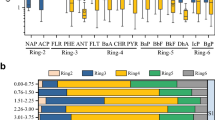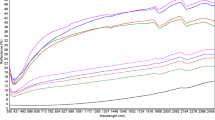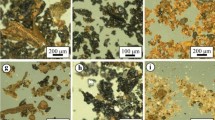Abstract
Purpose
The soil contamination by hydrophobic organic contaminants (HOCs), such as polycyclic aromatic hydrocarbons (PAHs), poses great threats to human health and ecological security and attracts worldwide concerns. The total HOC concentrations overestimate its available fraction to the soil biota. Increased understanding of the availabilities of PAHs in soil environment will have considerable benefits for their risk assessment and be very instructive to food safety and remediation strategies in contaminated sites. However, the availability of PAHs in aging soils and particularly the correlations of the availabilities with their forms in soils have yet to be elucidated. In this work, the availabilities of PAHs in aging soils were evaluated using a sequential mild extraction technique.
Materials and methods
Four typical zonal soils in China previously free of PAHs were collected from A (0–20 cm) horizon, air-dried, and sieved. Soils were spiked with a solution of phenanthrene and pyrene as representative PAHs in acetone. After the acetone evaporated off, the treated soils were progressively diluted with unspiked soils and sieved again several times to homogenize the soil samples. The forms of PAHs in soils were experimented using microcosms that are similar to those reported in literature. Various treated soils were packed into amber glass microcosms (each with 25 g soil). Three replications were given for each treatment. NaN3 solution (0.5%) was added to some microcosms in order to get the microbe-inhibited treatments. The soil water contents were adjusted to be 20% of soil water-holding capacity. After incubation for 0, 2, 4, 8, 12, and 16 weeks in microcosms with a temperature of 25°C, the soils were sampled. PAHs were then extracted by a sequential mild extraction technique, and their forms and availabilities were determined.
Results and discussion
The available residual concentrations of phenanthrene and pyrene generally decreased with aging time, and the PAHs were more readily available at the start of the incubation, but their availabilities decreased rapidly with increasing the soil-PAH contact time. In addition, the degradation efficiency of the available PAHs in soils was generally higher for PAHs with low molecular weight. The available residues of PAHs in soils were fractionated into desorbing and non-desorbing fractions. The desorbing fractions were the largest portion of the available PAHs in soils. In addition, the desorbing fractions were the main portion to be readily biodegradable. The non-desorbing fractions of PAHs were less bioavailable and with less possibility to be biodegraded in soils. The dissipation of the desorbing PAH fractions accounted for the dominant contribution to the dissipation of the available fractions of tested PAHs. The formation of bound PAH residues was observed in soils. However, the concentrations of the bound residual PAHs were very low. Comparing with the microbial biodegradation, the transformation of PAHs from available fractions to bound residues was a negligible contribution to the dissipation of available fractions of tested PAHs in soils.
Conclusions
A mild extraction technique was utilized for the evaluation of the availabilities of phenanthrene and pyrene in aging soils. We found that the available residues of tested PAHs generally decreased with time resulting dominantly from microbial biodegradation. The desorbing fractions were the largest portion of the available fractions of PAHs. The dissipation of the desorbing PAH fractions accounted for the dominant contribution to dissipation of the available fractions of tested PAHs, and in contrast, the transformation of PAHs from available fractions to their bound residues contributed little to the dissipation of their available residues in soils. In this work, the correlations of the availability of PAHs with their forms in soils were elucidated, and a useful method on this subject was provided, which would be very instructive to other HOCs in soil environment.




Similar content being viewed by others
References
Alexander M (2000) Aging, bioavailability, and overestimation of risk from environmental pollutants. Environ Sci Technol 34:4259–4265
Bogan BW, Sullivan WR (2003) Physicochemical soil parameters affecting sequestration and mycobacterial biodegradation of polycyclic aromatic hydrocarbons in soil. Chemosphere 52:1717–1726
Bogolte BT, Ehlers GAC (2007) Estimation of PAH bioavailability to Lepidium sativum using sequential supercritical fluid extraction—a case study with industrial contaminated soils. Eur J Soil Sci 43:242–250
Chung N, Alexander M (2002) Effect of soil properties on bioavailability and extractability of phenanthrene and atrazine sequestered in soil. Chemosphere 48:108–115
Cuypers C, Pancras T, Grotenhuis T, Rulkens W (2002) The estimation of PAH bioavailability in contaminated sediments using hydroxypropyl-β-cyclodextrin and triton X-100 extraction techniques. Chemosphere 46:1235–1245
Dec J, Haider K, Rangaswamy V (1997) Formation of soil-bound residues of cyprodinil and their plant uptake. J Agric Food Chem 45:514–520
Derudi M, Venturini G, Lombardi G (2007) Biodegradation combined with ozone for the remediation of contaminated soils. Eur J Soil Biol 43:297–303
Fernández-Luqueño F, Marsch R, Espinosa-Victoria D (2008) Remediation of PAHs in a saline–alkaline soil amended with wastewater sludge and the effect on dynamics of C and N. Sci Total Environ 402:18–28
Führ F, Mittelstaedt W (1980) Plant experiment on the bioavailability of un-extracted carbonyl-14C methabenzthiazuron residues from soil. J Agric Food Chem 28:122–125
Gao YZ, Ling WT (2006) Comparison for plant uptake of phenanthrene and pyrene from soil and water. Biol Fertil Soils 42:387–394
Gao YZ, Zhu LZ (2004) Plant uptake, accumulation and translocation of phenanthrene and pyrene in soils. Chemosphere 55:1169–1178
Gao YZ, Zhu LZ, Ling WT (2005) Application of the partition-limited model for plant uptake of organic chemicals from soil and water. Sci Total Environ 336:171–182
Gao YZ, Ling WT, Wong MH (2006) Plant-accelerated dissipation of phenanthrene and pyrene from water in the presence of a nonionic-surfactant. Chemosphere 63:1560–1567
Gao YZ, Xiong W, Ling WT, Wang XR, Li QL (2007) Impact of exotic and inherent dissolved organic matter on phenanthrene sorption by soils. J Hazard Mater 140:138–144
Gao YZ, Zeng YC, Shen Q, Ling WT, Han J (2009) Fractionation of polycyclic aromatic hydrocarbon residues in soils. J Hazard Mater 172:897–903
Gunasekara AS, Simpson MJ, Xing B (2003) Identification and characterization of sorption domains in soil organic matter using structurally modified humic acid. Environ Sci Technol 37:852–858
Hatzinger PB, Alexander M (1995) Effect of aging of chemicals in soil on their biodegradability and extractability. Environ Sci Technol 29:537–545
Heemken OP, Theobald N, Wenclawiak BW (1997) Comparison of ASE and SFE with soxhlet, sonication and methanolic saponification extractions for the determination of organic micropollutants in marine particulate matter. Anal Chem 69:2171–2180
Horinouchi M, Nishio Y, Shimpo E (2000) Removal of polycyclic aromatic hydrocarbons from oil-contaminated Kuwaiti soil. Biotechnol Lett 22:687–691
Hund-Rinke K, Simon M (2008) Bioavailability assessment of contaminants in soils via respiration and nitrification tests. Environ Pollut 153:468–475
Johnson DL, Jones KC, Langdon CJ, Piearce TG, Semple KT (2002) Temporal changes in earthworm availability and extractability of polycyclic aromatic hydrocarbons in soil. Soil Biol Biochem 34:1363–1370
Kastner M, Breuer-Jammali M, Mahro B (1998) Impact of inoculation protocols, salinity and pH on the degradation of polycyclic aromatic hydrocarbons (PAHs) and survival of PAH-degrading bacteria introduced into soil. Appl Environ Microbiol 64:359–362
Leahy JG, Colwell RR (1990) Microbial degradation of hydrocarbons in the environment. Microbiol Rev 54:305–315
Lesan HM, Bhandari A (2004) Contact-time-dependent atrazine residue formation in surface soils. Water Res 38:4435–4445
Ling WT, Ren LL, Gao YZ, Zhu XZ, Sun BQ (2009) Impact of low-molecular-weight organic acids on the availability of phenanthrene and pyrene in soil. Soil Biol Biochem 41:2187–2195
Liste HH, Alexander M (2002) Butanol extraction to predict bioavailability of PAHs in soil. Chemosphere 46:1011–1017
Loiseau L, Barriuso E (2002) Characterization of the atrazine's bound (non-extractable) residues using fractionation techniques for soil organic matter. Environ Sci Technol 36:683–689
Macleod CJA, Semple KT (2003) Sequential extraction of low concentrations of pyrene and formation of non-extractable residues in sterile and non-sterile soils. Soil Biol Biochem 35:1443–1450
Mckeague JA (1978) A manual of soil sampling and methods of analysis. Canadian Society of Soil Science, Ottawa
Nam K, Chung N, Alexander M (1998) Relationship between organic matter content of soil and the sequestration of phenanthrene. Environ Sci Technol 32:3785–3788
Noordkamp ER, Grotenhuis JTC, Rulkens WH (1997) Selection of an efficient extraction method for the determination of polycyclic aromatic hydrocarbons in contaminated soil and sediment. Chemosphere 35:1907–1917
Pignatello JJ, Xing B (1996) Mechanisms of slow sorption of organic chemicals to natural particles. Environ Sci Technol 30:1–11
Ramírez ME, Zapién B, Zegarra HG (2009) Assessment of hydrocarbon biodegradability in clayed and weathered polluted soils. Int Biodeterior Biodegrad 63:347–353
Reid BJ, Stokes JD, Jones KC, Semple KT (2000) Nonexhaustive cyclodextrin-based extraction technique for the evaluation of PAH bioavailability. Environ Sci Technol 34:3174–3179
Richnow HH, Annweiler E, Koning M, Lüth JC, Stegmann R, Garms C, Francke W, Michaelis W (2000) Tracing the transformation of labelled [1-13C] phenanthrene in a soil bioreactor. Environ Pollut 108:91–101
Sabate J, Vinas M, Solanas AM (2006) Bioavailability assessment and environmental fate of polycyclic aromatic hydrocarbons in biostimulated creosote-contaminated soil. Chemosphere 63:1648–1659
Saison C, Perrin-Ganier C, Amellal S, Morel J, Schiavon M (2004) Effect of metals on the adsorption and extractability of 14C-phenanthrene in soils. Chemosphere 55:477–485
Semple KT, Morriss AWJ, Paton GI (2003) Bioavailability of hydrophobic organic contaminants in soils: fundamental concepts and techniques for analysis. Eur J Soil Sci 54:809–818
Shieh WJ, Hedges AR (1996) Properties and applications of cyclodextrins. J Macromol Sci Pure Appl Chem A33(5):673–683
Singleton I (1994) Microbial-metabolism of xenobiotics: fundamental and applied research. J Chem Technol Biotechnol 59:9–23
Smith MJ, Lethbridge G, Burns RG (1999) Fate of phenanthrene, pyrene and benzo[a]pyrene during biodegradation of crude oil added to two soils. FEMS Microbiol Lett 173:445–452
Swindell AL, Reid BJ (2006) Comparison of selected non-exhaustive extraction techniques to assess PAH availability in dissimilar soils. Chemosphere 62:1126–1134
Tang JX, Liste HH, Alexander M (2002) Chemical assays of availability to earthworms of polycyclic aromatic hydrocarbons in soil. Chemosphere 48:35–42
Tao YQ, Zhang SZ, Wang ZJ (2008) Biomimetic accumulation of PAHs from soils by triolein-embedded cellulose acetate membranes (TECAMs) to estimate their bioavailability. Water Res 42:754–762
Trapido M (1999) Polycyclic aromatic hydrocarbons in Estonian soil: contamination and profiles. Environ Pollut 105:67–74
Wilson SC, Jones KC (1993) Bioremediation of soil contaminated with polynuclear aromatic hydrocarbons (PAHs): a review. Environ Pollut 81:229–249
Xu R, Jeffrey PO (2004) Biodegradation of polycyclic aromatic hydrocarbons in oil-contaminated beach sediments treated with nutrient amendments. J Environ Qual 33:861–867
Yaws CL (1999) Chemical properties handbook. McGraw-Hill Book Co., pp 340–389
Yuan SY, Wei SH, Chang BV (2000) Biodegradation of polycyclic aromatic hydrocarbons by a mixed culture. Chemosphere 41:1462–1468
Zhu LZ, Gao YZ (2004) Prediction of phenanthrene uptake by plants with a partition-limited model. Environ Pollut 131:505–508
Acknowledgements
This research was supported by the National Natural Science Foundation of China (40971137, 40701073), the Natural Science Foundation of Jiangsu Province (BK2009315), the Program for New Century Excellent Talents in University (NCET-06-0491), and the International Foundation for Science (C/4568-1).
Author information
Authors and Affiliations
Corresponding author
Additional information
Responsible editor: Jianming Xu
Rights and permissions
About this article
Cite this article
Ling, W., Zeng, Y., Gao, Y. et al. Availability of polycyclic aromatic hydrocarbons in aging soils. J Soils Sediments 10, 799–807 (2010). https://doi.org/10.1007/s11368-010-0187-5
Received:
Accepted:
Published:
Issue Date:
DOI: https://doi.org/10.1007/s11368-010-0187-5




